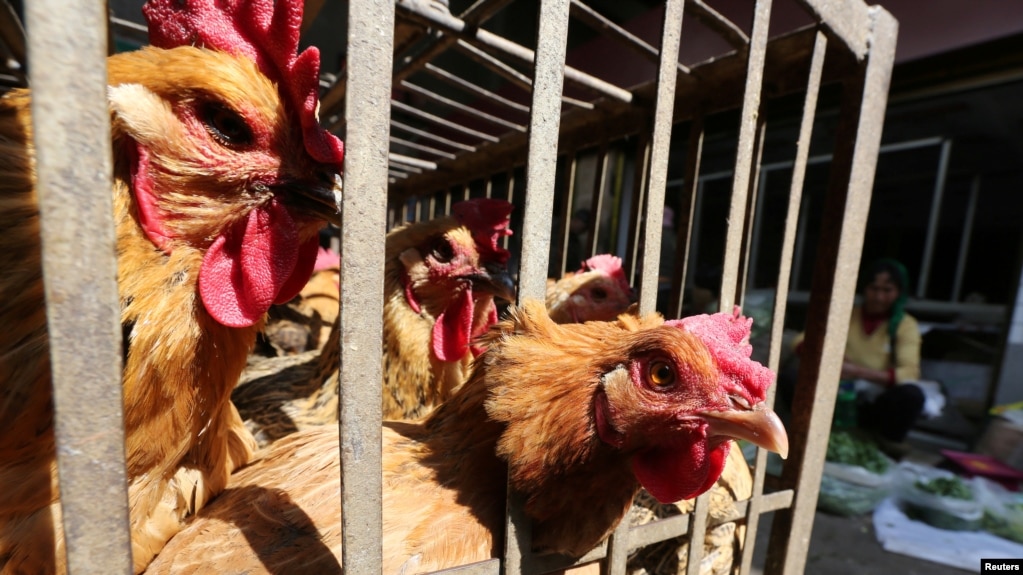次は鳥インフルが我々を襲う
信じられません!!
コロナの次は、鳥インフルの人への感染拡大なんて。
中国が発祥源です。
生きた動物がマーケットで売られ、裏庭で家畜を飼う暮らし方。
衛生管理と教育の問題ですよね。
さらに驚きだったのは、中国が今や世界最大の家禽生産国だと言う事です。
これは食料問題にもつながります。
と、ヤキモキしながら聞いていると、またもや、中国地名の英語発音に戸惑い。。。
日本語読みでしか認知してないので、日本語って便利なような不便なような。
中国語でイタリアは 「意大利」 [Yìdàlì] だそうです。
Sichuan:sìtʃwɑ'ːn 四川省
Guilin city:gilin 桂林市
Guangxi area:kwanʃi 広西チワン族自治区(広西壮族自治区)
さて、本日もVOAで知識と英語力を磨きましょう!!
鳥インフルエンザ感染者の増加は、急速に変化する変異株の危険性を示している
Rise in Bird Flu Infections Show Risks of Fast-Changing Variants
中国で今年、鳥インフルエンザの感染者が増加していることが、専門家の間で懸念されています。彼らによると、以前の鳥インフルエンザ株が変化し、人への感染力が強くなっている可能性があるとのことです。
世界保健機関(WHO)によると、中国では2021年にH5N6型の鳥インフルエンザの人への感染が21件報告されている。これは、昨年は5件しか報告されていなかったことと比較しても明らかです。
この数字は、2017年にH7N9に感染した数百人に比べてはるかに低いものです。しかし、この感染症は深刻で、多くの人が重症化し、少なくとも6人が死亡しています。
「今年、中国で人の感染例が増えていることは懸念されます。高い死亡率をもたらすウイルスだからです。」と、Thijs Kuiken氏は言います。同氏は、オランダのロッテルダムにあるエラスムス大学医療センターで教鞭をとっています。
WHOは今月初めの声明で、H5N6ウイルスに感染した人のほとんどが家禽類と接触していたと発表しました。WHOは、人から人へのウイルス拡散は確認されていないと指摘しています。
声明では、リスクとヒトへの感染の増加を理解するために、さらなる調査が”緊急に”必要であると付け加えています。
ヒトのH5N6感染者が報告されている一方で、2020年2月以降、中国では家禽類でのH5N6の発生は報告されていません。
中国は世界最大の家禽生産国であり、アヒルの生産量もトップです。これらの動物は、多くのインフルエンザウイルスのキャリアとして機能します。
中国疾病管理予防センター(CDC)からは、H5N6のヒト感染例の増加についてコメントを得ることができませんでした。しかし、9月に同センターのウェブサイトに掲載された研究結果によると、H5N6の感染が拡大していることは、"家禽産業と人間の健康にとって深刻な脅威である "と述べられていました。
鳥インフルエンザウイルスは、家畜や野鳥の間で継続的に広がっていますが、人に感染することはほとんどありません。しかし、ウイルスの変化が増えていることは大きな懸念材料です。専門家は、人の間で容易に広がるウイルスの変異体(新バージョン)がパンデミックを引き起こす可能性を懸念しています。
H5N6の感染者数は、中国南西部の四川省で最も多くなっています。また、近隣の重慶市、広西チワン族自治区、広東省、安徽省、湖南省でも感染が報告されています。
少なくとも10件の症例は、昨年の冬にヨーロッパ中の養鶏場を襲い、中国の野鳥を殺したH5N8ウイルスと非常によく似たウイルスが原因であった。このことは、中国で発生したH5N6が新しい変異種である可能性を示唆しています。
Thijs Kuiken 氏は、「この変異種は、(人への)感染力が少し高いのかもしれません。あるいは、現在、家禽の中にこのウイルスが多く存在していて、そのために多くの人が感染しているのかもしれません」と語っています。
中国のCDCが9月に発表したレポートによると、四川省でウイルスを発症した4人は、自宅で家禽を飼育しており、死んだ鳥と接触していました。また、1人は発病の1週間前に生きた家禽市場でアヒルを買いました。
食糧農業機関のFilip Claes氏は次のように述べています。彼によると、中国では鳥インフルエンザに対して家禽類にワクチンを接種しているとのことです。しかし、昨年使用されたワクチンは、新型ウイルスに対しては一部しか防御できない可能性があると述べています。また、ワクチンは大規模な流行を防いでも、ウイルスの拡散を許してしまう可能性があるとも述べています。
中国農業農村省は、ロイター通信の求めたコメントに回答をしていません。
中国では裏庭の農場は一般的で、多くの人々が市場で生きた鶏を購入しています。
9月、広西チワン族自治区の桂林市当局は、市内の13の市場で生きた家禽類の取引を停止し、1年以内にすべての取引を終了すると発表しています。
Rise in Bird Flu Infections Show Risks of Fast-Changing Variants
An increase in the number of people in China infected with bird flu this year is raising concern among experts. They say an earlier bird flu strain appears to have changed and may be more infectious to people.
The World Health Organization (WHO) says China has reported 21 human infections with the H5N6 strain of bird flu in 2021. That compares with only five reported cases last year.
The numbers are much lower than the hundreds infected with H7N9 in 2017. But the infections are serious, with many severely ill and at least six dead.
"The increase in human cases in China this year is of concern. It's a virus that causes high mortality," said Thijs Kuiken. He teaches at the Erasmus University Medical Center in Rotterdam, The Netherlands.
The WHO said in a statement earlier this month that most of those infected with the H5N6 virus had come into contact with poultry. The WHO noted that there are no confirmed cases of human-to-human virus spread.
The statement added that further investigation was "urgently" required to understand the risk and the increase in human infections.
While human H5N6 cases have been reported, no outbreaks of H5N6 have been reported in poultry in China since February 2020.
China is the world's biggest poultry producer and top producer of ducks. These animals act as carriers for many flu viruses.
The Chinese Center for Disease Control and Prevention (CDC) could not be reached for comment on the rise in H5N6 human cases. But a study published on its website in September said the increasing spread of H5N6 is “a serious threat to the poultry industry and human health."
Bird flu viruses continuously spread in domestic and wild birds, but rarely infect people. However, the increase in changes of the viruses is a major concern. Experts worry that a variant – or new version -- of the virus that spreads easily between people could cause a pandemic.
The largest number of H5N6 infections have been in China’s southwestern Sichuan province. Cases have also been reported in neighboring Chongqing and Guangxi, as well as Guangdong, Anhui and Hunan.
At least 10 cases were caused by viruses very similar to the H5N8 virus that struck poultry farms across Europe last winter and killed wild birds in China. That suggests the latest H5N6 infections in China may be a new variant.
Thijs Kuiken said, "It could be that this variant is a little more infectious (to people)...or there could be more of this virus in poultry at the moment and that's why more people are getting infected."
Four of the people who developed the virus in Sichuan raised poultry at home and had been in contact with dead birds, according to a September report by China's CDC. Another had bought a duck from a live poultry market a week before developing signs of illness.
Filip Claes is with the Food and Agriculture Organization. He said China vaccinates poultry against bird flu. But he said the vaccine used last year may only partly protect against new viruses. He added that the vaccine may prevent large outbreaks, but still permit the virus to keep spreading.
China’s Ministry of Agriculture and Rural Affairs did not respond to a Reuters request for comment.
Backyard farms in China are common, and many people still buy live chickens at markets.
In September, officials in Guilin city in the Guangxi area said trading of live poultry in 13 city markets had been suspended and that all trade would end within a year.
__________________________________________
Words in This Story
strain – n. a group of closely related living things that look similar but possess one or more unique characteristics
poultry – n. birds such as chickens and ducks that are raised on farms for their eggs or meat
outbreak – n. a sudden start or increase of fighting or disease
domestic – adj. living with or under the care of human beings
province – n. any one of the large parts that some countries are divided into
backyard – n. an area in back of a house
